-
Countries
-
Data and Analysis
-
Special Focus
-
Crisis Responses
Flow Monitoring

Contact
DTM Europe, DTMMediterranean@iom.int
Language
English
Location
Bosnia & Herzegovina
Period Covered
Jan 01 2024
Jan 31 2024
Activity
- Survey
- Flow Monitoring
This report provides insights into the profiles, experiences, needs, routes travelled and intentions of migrants transiting through Bosnia and Herzegovina (BiH).1 Data was collected from 3 January to 31 January 2024. IOM carried out a route observation exercise in the Republika Srpska, Sarajevo Canton, Posavina Canton, Tuzla Canton, Bosnian-Podrinje Canton and Una Sana Canton to monitor trends in entries and exits as well as transit modalities within BiH. IOM also surveyed 872 migrants in active transit locations such as bus stops or at key entry and exit locations throughout the country as well as in four transit reception centres (TRCs) in BiH (Lipa, Ušivak, Borići and Blažuj).

Contact
iomguatemala@iom.int
Language
English
Location
Guatemala
Period Covered
Jan 01 2024
Jan 31 2024
Activity
- Flow Monitoring
In January 2024, 23,690 movements were observed in Guatemala (16% children) and 564 individuals were surveyed.1 The number of observed movements increased by 29 per cent from December 2023 (18,390) due to the usual declining trend in movements around end-of-year festivities. More than half of movements originated from the Bolivarian Republic of Venezuela (53%). The main intended destination was the Unites States of America (87%).
Since 2022, migratory flows through the Latin America and Caribbean region have increased significantly, with record levels of persons crossing the perilous jungle of the Darién National Park from Colombia into Panama. The in-transit flows tracked in Guatemala have mirrored these regional migration trends.
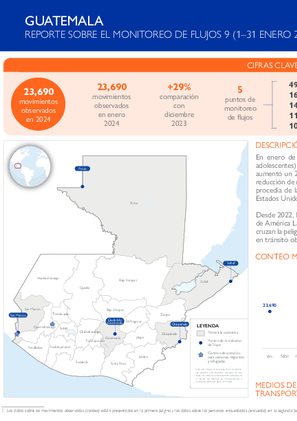
Contact
iomguatemala@iom.int
Language
English
Location
Guatemala
Period Covered
Jan 01 2024
Jan 31 2024
Activity
- Flow Monitoring
En enero de 2024 se observaron 23,690 movimientos en Guatemala (16% niños, niñas y adolescentes) y 564 personas fueron encuestadas.1 El número de movimientos observados aumentó un 29 por ciento desde diciembre de 2023 (18,390) debido a la tendencia habitual de reducción de movimientos por las festividades de fin de año. Más de la mitad de los movimientos procedía de la República Bolivariana de Venezuela (53%). El principal destino previsto fue los Estados Unidos de América (87%).
Desde 2022, los flujos de migrantes en tránsito se incrementaron significativamente en la región de América Latina y el Caribe, observando cantidades nunca antes registradas de personas que cruzan la peligrosa selva del Parque Nacional del Darién desde Colombia hacia Panamá. Los flujos en tránsito observados en Guatemala han reflejado dichas tendencias migratorias regionales.

Contact
DTM Libya, DTMLibya@iom.int
Language
English
Location
Libya
Period Covered
Oct 01 2023
Dec 31 2023
Activity
- Flow Monitoring
- Mobility Tracking
- Baseline Assessment
This infographic presents the key findings of Round 50 of the mobility tracking and flow monitoring components of the Displacement Tracking Matrix (DTM) programme in Libya.
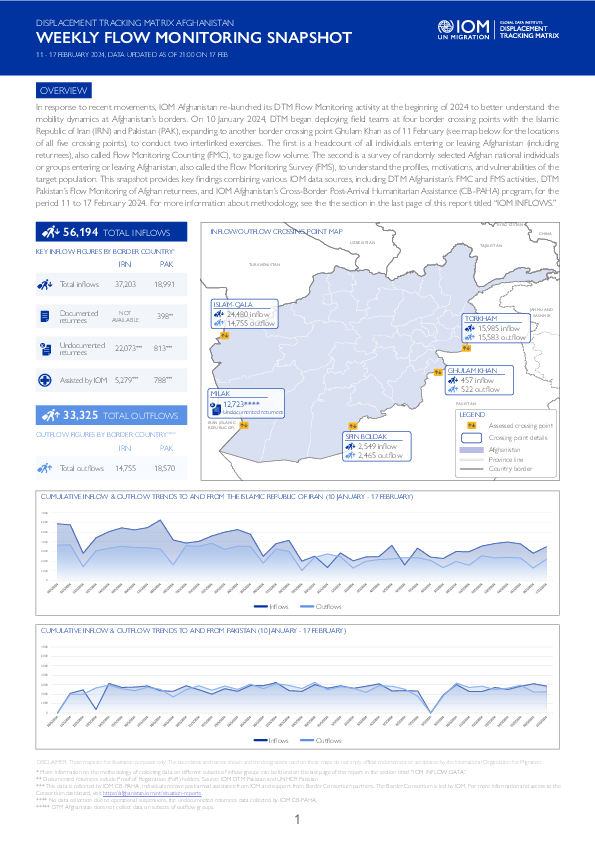
Contact
DTMAfghanistan@iom.int
Language
English
Location
Afghanistan
Period Covered
Feb 11 2024
Feb 17 2024
Activity
- Survey
- Flow Monitoring Survey
- Flow Monitoring
In response to recent movements, IOM Afghanistan re-launched its DTM Flow Monitoring activity at the beginning of 2024 to better understand the mobility dynamics at Afghanistan’s borders. On 10 January 2024, DTM began deploying field teams at four border crossing points with the Islamic Republic of Iran (IRN) and Pakistan (PAK), expanding to another border crossing point Ghulam Khan as of 11 February (see map below for the locations of all five crossing points), to conduct two interlinked exercises. The first is a headcount of all individuals entering or leaving Afghanistan (including returnees), also called Flow Monitoring Counting (FMC), to gauge flow volume. The second is a survey of randomly selected Afghan national individuals or groups entering or leaving Afghanistan, also called the Flow Monitoring Survey (FMS), to understand the profiles, motivations, and vulnerabilities of the target population. This snapshot provides key findings combining various IOM data sources, including DTM Afghanistan’s FMC and FMS activities, DTM Pakistan’s Flow Monitoring of Afghan returnees, and IOM Afghanistan’s Cross-Border Post-Arrival Humanitarian Assistance (CB-PAHA) program, for the period 11 to 17 February 2024. For more information about methodology, see the the section in the last page of this report titled “IOM INFLOWS.”

Contact
DTM Libya, DTMLibya@iom.int
Language
English
Location
Libya
Period Covered
Oct 01 2023
Dec 30 2023
Activity
- Flow Monitoring
- Migrants presence
- Mobility Tracking
- Baseline Assessment
IOM Libya’s Displacement Tracking Matrix (DTM) programme identified a total of 706,509 migrants from 45 nationalities in the 100 Libyan municipalities during round 50 of data collection (October - December 2023). The number of migrants in Libya increased slightly compared to the previous round of data collection (from 697,532 migrants, round 49 to 706,509 migrants, round 50).
Despite improvement in the overall migrant unemployment rate, around half of female migrants continue to be unemployed and actively seeking work (49%) — more than three times the percentage of males (14%). At the same time, financial issues continue to be the main difficulties faced by the majority of migrants, regardless of sex or age. DTM Libya data further shows that economic constraints are the main obstacle impeding migrants’ access to essential services including healthcare, clean drinking water and education for their children.
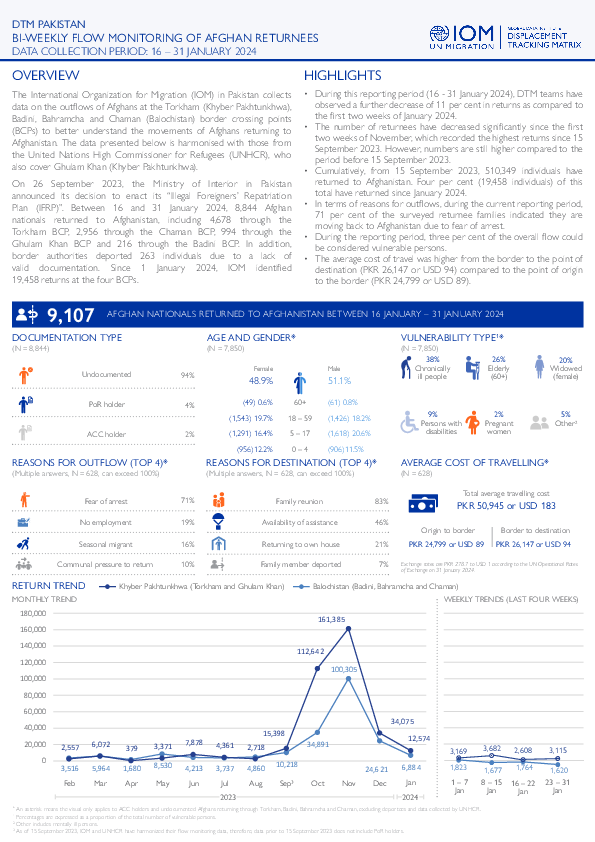
Contact
DTMPakistan@iom.int
Language
English
Location
Pakistan
Period Covered
Jan 16 2024
Jan 31 2024
Activity
- Flow Monitoring
On 26 September 2023, the Ministry of Interior in Pakistan announced its decision to enact its “Illegal Foreigners’ Repatriation Plan (IFRP)”. Between 16 and 31 January 2024, 8,844 Afghan nationals returned to Afghanistan, including 4,678 through the Torkham BCP, 2,956 through the Chaman BCP, 994 through the Ghulam Khan BCP and 216 through the Badini BCP. In addition, border authorities deported 263 individuals due to a lack of valid documentation. Since 1 January 2024, IOM identified 19,458 returns at the four BCPs.
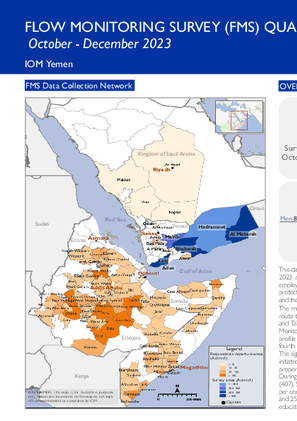
Contact
DTM Yemen, DTMYemen@iom.int
Language
English
Location
Yemen
Period Covered
Oct 01 2023
Dec 31 2023
Activity
- Survey
- Flow Monitoring Survey
- Flow Monitoring
This dashboard compiles flow monitoring survey (FMS) data collected in Yemen between October and December 2023 and provides an analysis of migrants’ demographic and socio-economic profiles, including education and employment backgrounds, reasons for leaving their country of origin or habitual residence, future travel intentions, protection and challenges faced during the journey. Also included are migrants’ highest level of education achieved and their labour status prior to moving.
The migration routes in the southern part of Yemen are categorized along two main routes: the south-eastern route towards Shabwah, Hadramawt, and Al Maharah governorates and the north-eastern route towards Lahj and Ta’iz governorates. Both routes are travelled by a large number of migrants each year. Through the Flow Monitoring Registry tool, which focuses on total numbers of migrants (as opposed to the more detailed migrant profile established through the FMS).
DTM recorded 4,853 migrants entered Yemen through the south in the fourth quarter of 2023. This figure represents a significant decrease (-68%) compared to the previous quarter. The significant and steady decrease observed since August is likely attributed to the ongoing joint military campaign initiated to combat smuggling and secure the coastline of Lahj, a well-known governorate for receiving the largest proportion of migrants. The campaign involved deploying troops, conducting raids, and establishing checkpoints.
During the fourth quarter of 2023, a total of 2,897 surveys were conducted. In Aden (435), Lahj (636), Ma’rib (407), Shabwah (609), Hadramawt (174) and Al Maharah (636). The overall number of surveys increased by seven per cent over the previous quarter. The majority of respondents were young male adults between the age of 17 and 25 (75%) searching for economic opportunities (97%), most of whom were single (94%), attained primary education or less (61%), were currently unemployed (95%) and departed from rural areas (67%).
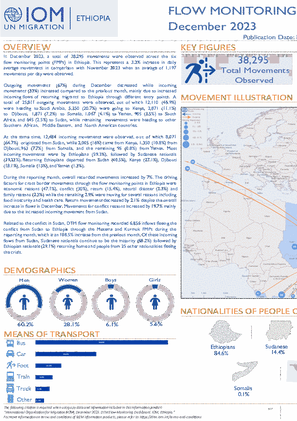
Contact
DTM Ethiopia, DTMEthiopia@iom.int
Language
English
Location
Ethiopia
Period Covered
Dec 01 2023
Dec 31 2023
Activity
- Flow Monitoring
In December 2023, a total of 38,295 movements were observed across the six flow monitoring points (FMPs) in Ethiopia. This represents a 3.2% increase in daily average movements in comparison with November 2023 when an average of 1,197 movements per day were observed.
Outgoing movements (67%) during December decreased while incoming movements (33%) increased compared to the previous month, mainly due to increased incoming flows of returning migrants to Ethiopia through different entry points. A total of 25,811 outgoing movements were observed, out of which 12,110 (46.9%) were heading to Saudi Arabia, 5,350 (20.7%) were going to Kenya, 2,871 (11.1%) to Djibouti, 1,871 (7.2%) to Somalia, 1,067 (4.1%) to Yemen, 905 (3.5%) to South Africa, and 645 (2.5%) to Sudan, while remaining movements were heading to other Southern African, Middle Eastern, and North American countries.
At the same time, 12,484 incoming movements were observed, out of which 8,071 (64.7%) originated from Sudan, while 2,005 (16%) came from Kenya, 1,350 (10.8%) from Djibouti, 963 (7.7%) from Somalia, and the remaining 95 (0.8%) from Yemen. Most incoming movements were by Ethiopians (59.3%), followed by Sudanese nationals (39.22%). Returning Ethiopians departed from Sudan (40.5%), Kenya (27.1%), Djibouti (18.1%), Somalia (13%), and Yemen (1.3%).
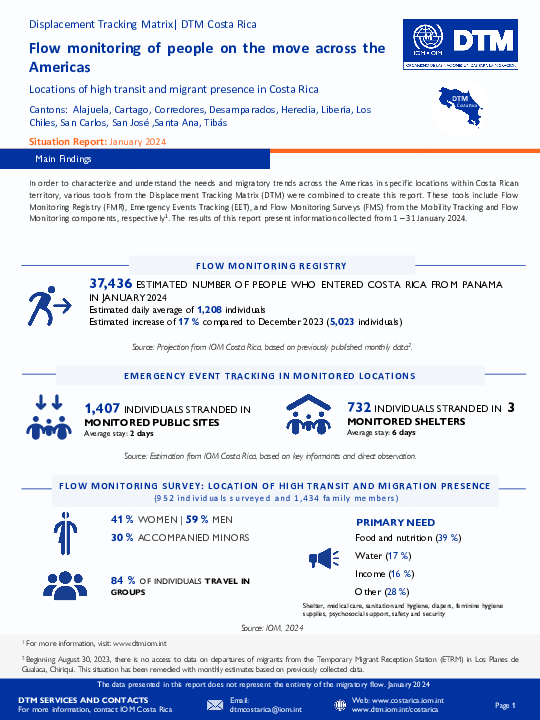
Contact
DTMCostaRica@iom.int
Language
English
Location
Costa Rica
Period Covered
Jan 01 2024
Jan 30 2024
Activity
- Flow Monitoring
- Mobility Tracking
- Event Tracking
Cantons: Alajuela, Cartago, Corredores, Desamparados, Heredia, Liberia, Los Chiles, San Carlos, San José, Santa Ana y Tibás
Costa Rica, like the other countries in the Central American region, has been characterized as a migratory corridor for people who transit by land from the south to the north of America and whose destination is the countries in the north of the continent. This flow on the move through the Americas is mainly made up of people from the Bolivarian Republic of Venezuela, Cuba, Haiti, Ecuador, as well as people from other countries in South America, Africa and Asia.
According to estimations from IOM Costa Rica, during December 37,436 people entered the country, an approximate average of 1,208 people per day and estimating a increase of 30% compared to December 2023. In addition, 1,407 people stranded in the monitored shelters were identified and 732 people stranded in the public places visited.
Pagination
- Previous page
- Page 26
- Next page